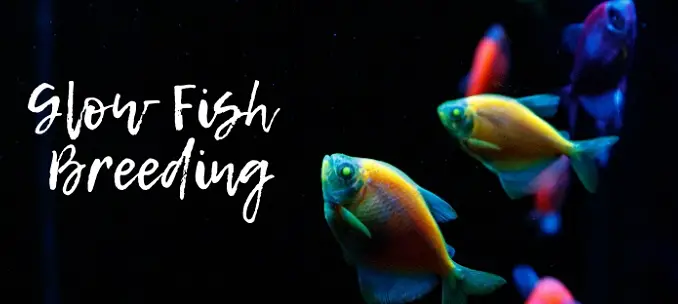
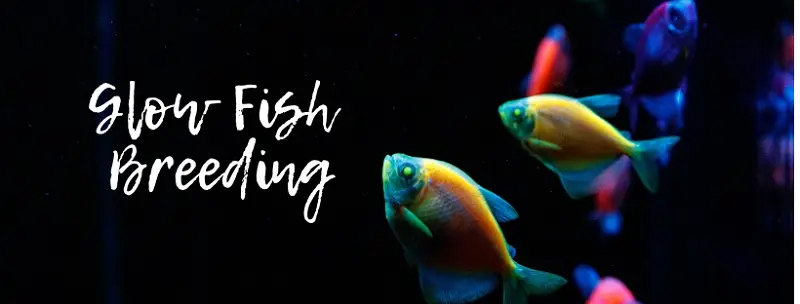
Most people have either seen glow fish in aquariums or heard of glow fish. One thing is for sure, you have never seen a glow fish out in the wild. That is because these fish are genetically modified in laboratories which enables their glowing characteristics.
Glow fish are ‘tampered’ and modified fish that have one sole scientific purpose, to detect how environmental pollution changes to the tissue. The idea was for the fish to only become fluorescent when pollution is detected in the water.
To achieve this goal, first, the fish must become florescent in the first place. Scientists took a zebra danio embryo and injected it with natural fluorescent genes such as jellyfish protein or sea coral. Each type of protein made the fish glow a different color.
The scientists from NUS that successfully created this spectacular fish patented their new creation and branded it GloFish. Because the fish are genetically modified and essentially a patented ‘invention’ only the GloFish company can sell these funky fish. Any glow fish you may see in aquariums today are sold by GloFish.
That doesn’t mean that you can not breed them at home. We will be touching on the rules you must follow when breeding these fish at home and what you can and can’t do with your new special friends.
Read Related Article: Axolotl Breeding
How Many Species of GloFish are There Today?
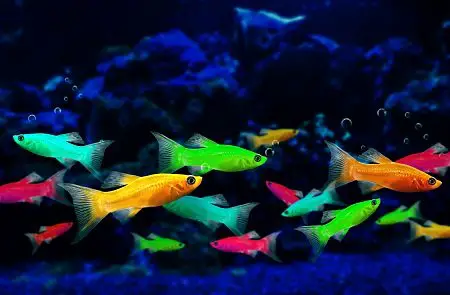
There are four species of GloFish available on the market today. GlowFish barbs, originating from tiger barbs. These are fish that will live for up to 3 years when cared for correctly. They reach about 2 inches in length and only need a little tank of approximately 5 gallons to be happy.
GloFish tetras are just as easy to care for, they too only need a little tank and water temperatures of between 72 and 82 degrees Fahrenheit. You can have GloFish tetra in a tank with other little fish such as danios, mollies, platies, and dwarf cichlids.
Next on the list is our trusty GloFish danios, the first of the Glofish creations and GloFish family. These little cuties can live up to a whopping 5 years. Keep them in a tank with other little fish like guppies, swordtails, barbs, and rainbows.
Finally, we have the GloFish rainbow shark. These beauties do need a slightly bigger tank to keep them happy, a 20-gallon tank should be enough.
Contrary to their name, these aren’t actually sharks, nor are they related to them in any way. Rainbow sharks are part of the Cyprinidae family. Be careful though, rainbow sharks are aggressive towards their own species, so it is best to keep just one in a tank.
Where in the World Are GloFish Illegal?
The FDA is in charge of regulating these fish, however, because these tropical fish are not considered a threat, the FDA hasn’t chosen to regulate GloFish at this moment in time. There is no evidence that these fish are any more harmful or beneficial to the environment than the original on genetically modified fish.
That being said, there is still some general upset about GloFish as a whole, especially when it comes to selling them in America. The Center for Food Safety has been very active in trying to ban all sales of Glofish in the USA.
GloFish are legal all over the USA, apart from one state, California. The reason for this is that there is a big concern over biotech salmon and fears that GloFish will contaminate them.
Australia, Canada, and European countries had banned GloFish all together. Now, Australia will consider the importation of GloFish, but only with prior authorization. To date, Australia has not authorized any GloFish importation at all.
These rules are constantly being reviewed and changed. If you do want GloFish and are unsure if they are legal where you are, you should take a look at your government website for up to date rules before making a purchase. One thing that will forever stay constant, is that GloFish, or any other genetically modified fish for that matter, should never be released into the wild.
Do GlowFish Stay Fluorescent When They Breed?
Although GloFish are genetically modified fish, when they breed, their offspring will glow too. That is not to say that a few generations down the line GloFish that breed in your aquarium won’t be duller and resemble their original counterparts more.
How Often Will GloFish Lay Eggs?
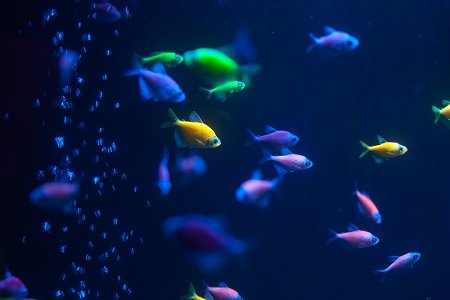
Let’s have a look at the most popular GloFish, the zebra danio. The egg-laying habits and natural instincts of this fish is the same, even though this is a genetically modified fish. The only real difference between the two fish is the way they look, their temperament, breeding, and egg-laying habits are no different from the original zebra danio fish.
Danios are not live breeders, that means that the fish do not get pregnant, they lay eggs that will be fertilized by the male. Zebra danios can lay eggs every few days when the tank conditions are suitable.
GloFish danios like to breed in spawns, this means that they do it in groups, rather than having just one male with one female. The female fish will deposit her eggs and the male will swim behind her and fertilize them.
Fun Fact: Due to the danio GloFish spawning methods, the eggs will most probably be fertilized by more than one male.
Is It Illegal to Breed GloFish?
There are a few rules and regulations regarding GloFish breeding. If you do breed your GloFish, you must never sell, barter or give your GloFish away. These rules are so strict because the fish are patent protected.
You are also not allowed to release the fish into the wild. Doing so comes with serious consequences. If you do breed GloFish, make sure you have the sufficient resources to look after them. Because GloFish are so easy to breed, if you look after the fry and eggs properly, you will get a good number of fish from each spawning session. These are all things to keep in mind.
How Do I Breed GloFish?
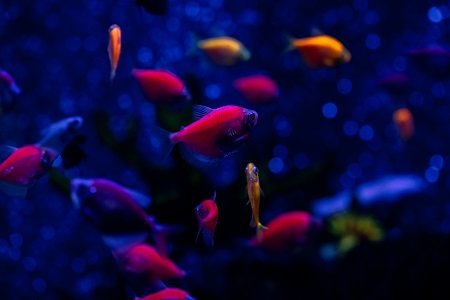
As we mentioned earlier, GloFish breed in groups, otherwise known as spawns. You should have a separate breeding tank for the fish. This is to ensure the adults do not eat the eggs or the fry.
We will have a look at the GloFish danios again in this section, however, the same steps can be taken for most GloFish breeds. Danios are very easy to breed. Male and female danios must be kept separate for roughly two weeks before putting them into the breeding tank together.
It is important to feed the fish well before reintroduction. They should eat live food such as mosquito larvae and bloodworms, food flakes or frozen flakes.
Once the fish have been introduced into the tank together they will start breeding within 48 hours. You should keep a close eye on the fish. Once you notice the females have laid eggs, quickly remove the adults from the tank.
There is a chance that the fish won’t breed at all, this is a sign that you didn’t condition them correctly prior to reintroduction. In this case, you should separate the males and females from one another and for another week and ensure the tank conditions and food are right for them before attempting to breed them again.
Fun Fact: if you have all of the four FloFish species in one tank, don’t worry, they will not crossbreed.
Read Related Article: Breeding Corydoras
Tank Requirements For Breeding GloFish?
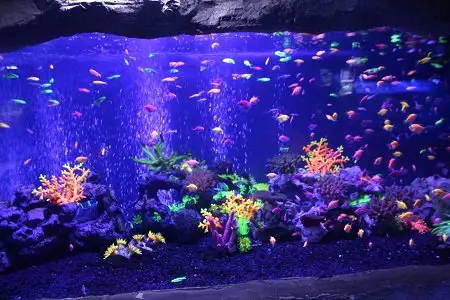
Have you ever heard of a marble substrate? If not, this is literally an aquarium floor covered completely in little round marbles. This will keep the eggs safe once they have been laid.
GloFish are freshwater fish, which means that their tank should be larger than 5 gallons and water temperature should be between 72 to 82 degrees Fahrenheit. Make sure that you use a good water conditioner to keep the natural gasses in the water balance.
Making sure that the tank has a good filter that will keep the tank clean and livable, doing so will stop the GloFish from becoming ill in the future. Having a well-filtered tank will also prompt the fish to breed.
GloFish Fun Facts
- GloFish comes in 6 different colors, if you breed a green fish with a purple fish, the offspring will either be green or purple. Not multi-colored.
- GloFish absorb light, when they are placed under white, UV or ultraviolet light, they then re-emit light.
- These fish are not injected or tampered with in any way, the genetically modified fish are bred just like any other fish.
- GloFish was created in 2003.
- Your colorful tank companions are just as likely to live a happy, long life as the rest of your ‘normal’ aquarium fish.
- GloFish are omnivores, which means that they eat both animals and vegetation.
- GloFish were developed by Yorktown Technologies, L.P.

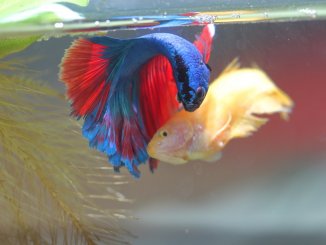
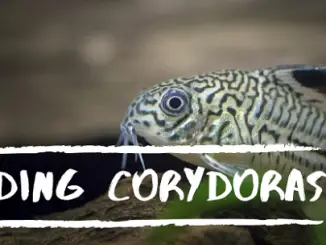
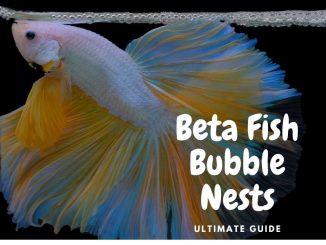
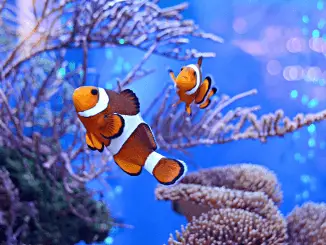
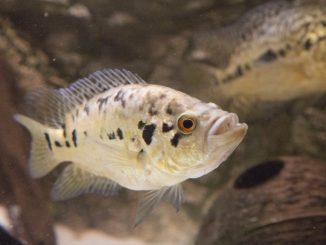
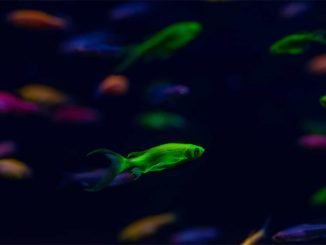
I found this article very informative and interesting. It gave me a good understanding of what to do should my egg carrying females start dropping their eggs if I want the fry to survive.
How to identify the difference between males and female for orange and green glofish tetra
Are the different color gene inserted into the same place in the fish’s genome? Does fish require to be a heterozgote for glo to survive? bc if you breed 2 colors you get one glo color or another. Are the glo genes inserted in the same locaton in the genome for all species? what gene?
They are all different colors. I don’t have experience with breeding egg layers
I have 8 glofish in a 20 gallon tank. One of my fish is pregnant, what should I do to keep the fish from eating the babies?
You need to remove the parents from the tank. You should ideally have a breeding tank set up where they breed then put thr parents back into normal tank bc they will eat both eggs and babies. When still egg form, turn off all lights and can cover tank w towel to prevent fungus from growing. Check on them often (they hatch rather qucikly). Use a sponge or peat filter…nothing with holes or it will suck the eggs or babies in and don’t get one that produces bubbles or bubbles can get under tetra scales and cause problems. One eggs hatch you can put on lights. Use black background so you can see them easily. Give them some live plants to hide around so they don’t stress. You will need to feed them initially. At first you can give them few drops of infusoria 3 times/day. If the fries are aggressive and seem hungrier than normal you can give brine shrimp right away. They start to swim in couple weeks and will be looking for food. Micro worms also work for food. When first born a cheap food is to boil an egg, take the yolk out and mix w a bit of water in a small squirt bottle, shake it up vigorously then put a few drops in for food. When they get big enough you can introduce then to the main tank.